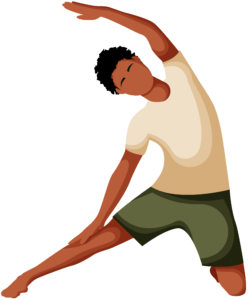Gate (Parighasana)
Pose Overview
| Common Name | Gate |
| Traditional Sanskrit Name | Parighasana |
| Sanskrit Name Pronunciation | par-ee-GAHS-ah-nuh |
| Pose Difficulty | Beginner |
| Drishti
Drishti is the gaze or visual focus point during yoga poses.
Learn more about Drishti |
Straight ahead or the nose |
Gate Pose, or Parighasana in Sanskrit, is a yoga pose that is said to be beneficial for stretching out the sides of the body, especially the obliques, as well as for promoting a sense of balance and focus. The name of the pose comes from the fact that it resembles a gate, with the body in a side-bending position and the arm extended overhead. The pose is said to be helpful for increasing flexibility and strength in the sides of the body, and for promoting a sense of balance and focus. It is also said to be beneficial for relieving stress and anxiety, and for promoting a sense of inner peace. This pose is also said to help to open the sides of the body, and to help to release tension in the obliques.
Benefits of Gate
Improves balance and stability Strengthens the legs Opens up the hips Stretches the hamstrings, spine, and shoulders Can help alleviate sciatica pain
How to Enter Gate
Begin in a standing position with your feet together Take a step forward with your right foot, keeping your feet about hip-distance apart Exhale and bend your right knee, making sure your right knee is directly over your right ankle Inhale and raise your left arm straight up towards the ceiling Exhale and reach your left hand towards the outside of your right foot, keeping your left arm parallel to the ground Hold the pose for a few deep breaths before releasing and repeating on the other side
How to Exit Gate
Inhale and raise your left arm back up to the ceiling Exhale and straighten your right leg Release the pose and step your feet back together
Common Gate Modifications & Variations
For those who have difficulty reaching their foot, a block can be placed outside the foot to help assist in the stretch For those who have difficulty keeping their balance, a wall can be used for support
Common Mistakes with Gate
Not keeping the knee directly over the ankle, which can put stress on the knee joint Not keeping the hips facing forward, which can put stress on the lower back Not keeping the back straight, which can put stress on the spine
Safety Guidance
Those with knee or hip injuries should be cautious in this pose and consult with a doctor or experienced teacher before attempting. Those with high blood pressure should avoid this pose

